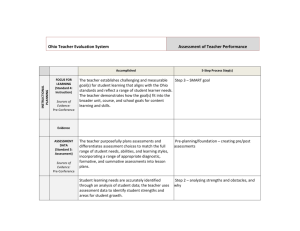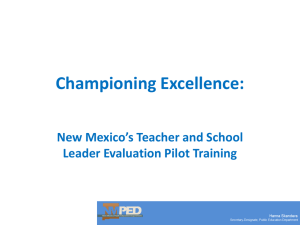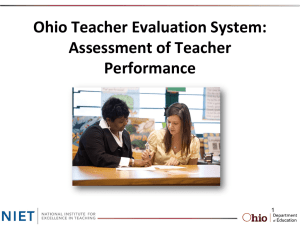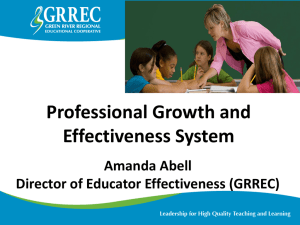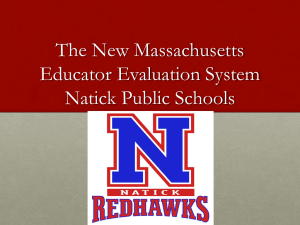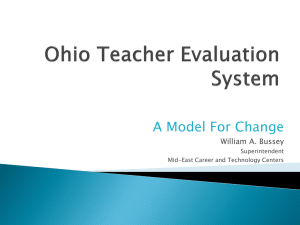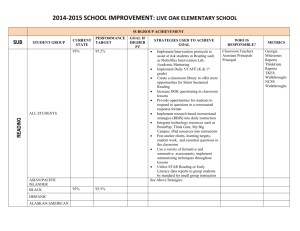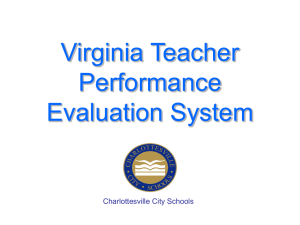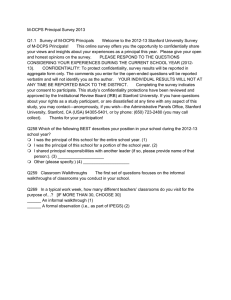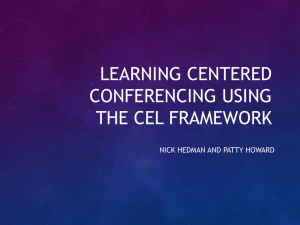Teacher Performance Presentation
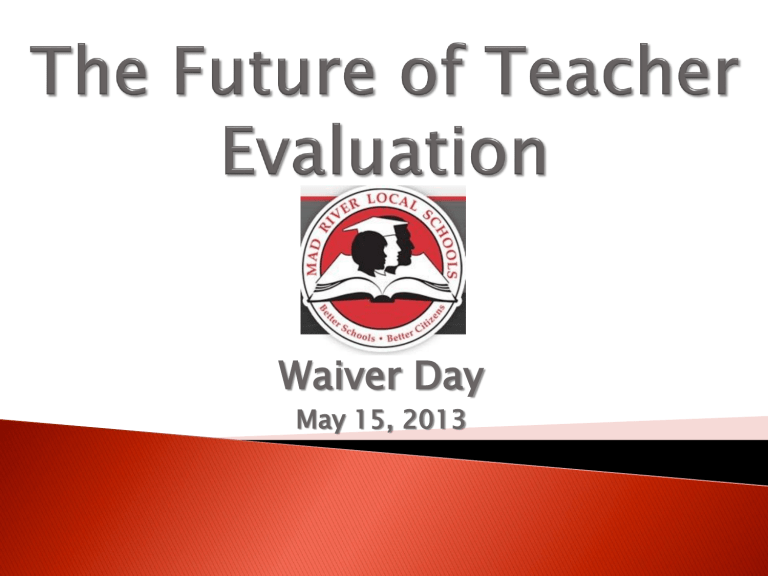
Waiver Day
May 15, 2013
Today’s presentation would not be possible without the hard work of the Evaluation
Committee and Mad River staff.
◦ Cristi Fields
◦ Bernie Gearon
◦ Pam Hillard
◦ Amy Holbrook
◦ Mary Isaacs
◦ Nora Monnin
◦ Necia Nicholas
◦ Beth Schmidt
◦ Brad Sims
◦ Krista Wagner
◦ Liz Wolfe-Eberly
◦ Chad Wyen
Understand the “Big Picture” of the OTES Evaluation System for next year
Practice with different pieces of
OTES Evaluation System
Leave with a peace of mind to enjoy your summer
Teacher Performance
50%
-
It is 7 step process beginning with a self assessment and ending with a final summative rating.
Student Growth Measures
50%
•
Value-Added
•
Vendor (STAR)
•
Student Learning
Objectives (SLOs)
•
We will discuss this half of OTES later in the day.
Step 1: Self Assessment
Step 2: Creating a Growth Plan
Step 3: Pre-Conference
Step 4: Observation
Step 5: Post-Conference
Step 6: Walkthroughs/Informal
Evaluations
Step 7: The Final Summative Rating
Record evidence of strengths and areas for growth in each of the 7 Standards for the Teaching
Profession.
Identify two priorities for the upcoming year by placing check marks in the far-right column.
Use these two priority areas for writing your
Professional Growth Plan.
May want to use this form during first preconference with evaluator to finalize selection of growth goals.
Using the two priorities from the Self-
Assessment or input from your evaluator, write two goals.
Use Teacher Performance Evaluation Rubric to select focus and wording.
Determine Evidence Indicators for each goal, as well as areas for professional growth.
Will be used to inform your holistic Teacher
Performance rating.
S pecific
M easurable
A ttainable
R elevant
T imely
Collaborative Learning:
◦ By March 2014, I will develop, teach, and evaluate 6 collaborative learning lessons, and share them with my grade-level team for feedback.
Parent Communication:
◦ By April 2014, I will make at least 5 positive contacts with my
10 lowest-performing students’ families, and will update my evaluator on their progress.
Goal Statement: Differentiation
◦ By April 2014, I will provide evidence of matching strategies, materials, and pacing to individual student needs in each of my science units of instruction.
Evidence Indicators:
◦ Pre-assessment data of students in each unit; Inventory of individual student learning styles; Plans of differentiated lessons with samples of strategies, materials and pacing
Date:
◦ September 27, 2013; January 21, 2014
Areas for Professional Growth:
◦ Differentiated instruction books and websites; Collegial visit to Mrs. X’s room to observe differentiation; Team meetings to discuss student needs
Step 1: Self Assessment
Step 2: Creating a Growth Plan
Step 3: Pre-Conference
Step 4: Observation
Step 5: Post-Conference
Step 6: Walkthroughs/Informal
Evaluations
Step 7: The Final Summative Rating
Review questions and consider how they could be answered based on your upcoming observation.
Not every question will be asked, these are just suggested questions.
Your pre-conference will be used to inform your
Teacher Performance rating.
At pre-conference you will also discuss
Professional Growth Goals and Student Growth
Measures.
Every teacher will have 2 formal observations.
The observations will be for an instructional period of no less than 30 minutes.
◦ Observation 1- Between September and November
15 th
◦ Observation 2- Between December and February 15 th
The OTES rubric is the focus of the observation.
Review the criteria and consider how they will be addressed in your upcoming observation.
Evaluator will use these criteria and collect evidence during your observation to inform a holistic ranking.
These criteria are the basis for both formal and informal observations.
Your ratings on these criteria will be used to inform you Teacher Performance rating.
1.
2.
3.
4.
5.
6.
7.
8.
9.
10.
Focus of Learning
Assessment Data
Prior Content
Knowledge/Sequence/Connections
Knowledge of Students
Lesson Delivery
Differentiation
Resources
Classroom Environment
Assessment of Student Learning
Professional Responsibilities
Goal is to reflect on the outcomes of the lesson.
Teachers should be prepared to discuss with evaluator:
◦ Strengths of the lesson
◦ Areas for refinement or improvement
Step 1: Self Assessment
Step 2: Creating a Growth Plan
Step 3: Pre-Conference
Step 4: Observation
Step 5: Post-Conference
Step 6: Walkthroughs/Informal
Evaluations
Step 7: The Final Summative Rating
Fits into the Holistic Approach to Evaluation
Everyone will have a minimum of 2 walkthroughs no more than 4
Walkthroughs should be about10-15 minutes.
Walkthroughs can be conducted anytime except for the three days before winter break and any day after the final summative rating.
The teacher will receive feedback within 5 school days
Step 1: Self Assessment
Step 2: Creating a Growth Plan
Step 3: Pre-Conference
Step 4: Observation
Step 5: Post-Conference
Step 6: Walkthroughs/Informal
Evaluations
Step 7: The Final Summative Rating
Professional Growth Plan
1
st
round of the
Observation Process
1st Walkthroughs
Instruction
2
nd
round of the
Observation Process
Walkthroughs
Instruction
Walkthroughs
Finalize Professional
Growth Plan
Final Summative
Rating
Student Growth Measures
50%
•
Value Added
•
Vendor (STAR)
•
Student Learning
Objectives (SLOs)
Find out your Student Growth
Category
Take a 10 minute break
Report to the correct place based on Student Growth Category
◦ Category A: Room ?
◦ Category B: Library
◦ Category C: Cafeteria
Teachers with only Value Added
Report to Room 212-214
Teachers
◦ 4 th - 6 th Grade teachers that
ONLY teach Math and
Language Arts
Teachers with Value Added and another growth measure
Report to Room 212-214
Teachers
◦ 4 th - 6 th Grade teachers that teach Math or
Language Arts and another subject with an SLO.
Teachers with STAR and another growth measure
Remain in cafeteria
Teachers
◦ Preschool-3 rd Grade teachers that have STAR or team with teachers that do.
Teachers without Value Added or STAR
Teachers that use SLOs as their growth measure.
Report to Room 104
Teachers
◦ K-6 PE
◦ K-6 Music
◦ Resource room only SpEd
Kindergarten-104
1st Grade-106
2nd Grade-111
3rd Grade-112
4th Grade-117
5th Grade-208
6th Grade-212
PE-Conference Room
Music-Music Room
Title I and Special Ed – Staff Development @ CO
